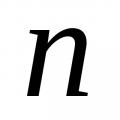Central symmetry presentation by Kulkina L. V
Axial and central symmetry

“ Symmetry is the idea through which man throughout the centuries tried to comprehend and create order, beauty and perfection.” German mathematician G. Weil

Symmetry (means “proportionality”) - the property of geometric objects to be combined with themselves under certain transformations. Symmetry is understood as any regularity in the internal structure of the body or figure.
Symmetry about a point is central symmetry, and symmetry about a straight line - this is axial symmetry.
Symmetry about a point assumes that there is something on both sides of the point at equal distances, for example other points or the locus of points (straight lines, curved lines, geometric figures).
Symmetry relative to a straight line (axis of symmetry) assumes that along a perpendicular drawn through each point of the axis of symmetry, two symmetrical points are located at the same distance from it. The same geometric figures can be located relative to the axis of symmetry (straight line) as relative to the point of symmetry.

The axis of symmetry serves as a perpendicular to the midpoints of the horizontal lines bounding the sheet. Symmetrical points (R and F, C and D) are located at the same distance from the axial line - perpendicular to the lines connecting these points. Consequently, all points of the perpendicular (axis of symmetry) drawn through the middle of the segment are equidistant from its ends; or any point perpendicular (axis of symmetry) to the middle of a segment is equidistant from the ends of this segment.
If you connect symmetrical points (points of a geometric figure) with a straight line through a symmetry point, then the symmetrical points will lie at the ends of the straight line, and the symmetry point will be its middle. If you fix the symmetry point and rotate the straight line, then the symmetrical points will describe curves, each point of which will also be symmetrical to the point of the other curved line.

Symmetry in architecture
Man has long used symmetry in architecture. The ancient architects made especially brilliant use of symmetry in architectural structures. Moreover, the ancient Greek architects were convinced that in their works they were guided by the laws that govern nature. By choosing symmetrical forms, the artist thereby expressed his understanding of natural harmony as stability and balance. Temples dedicated to the gods should be like this: the gods are eternal, they do not care about human concerns. The most clear and balanced buildings are those with a symmetrical composition. Symmetry gives harmony and completeness to ancient temples, towers of medieval castles, and modern buildings.
Sphinx at Giza
Aswan Mosque in Egypt

Symmetry in art
Symmetry is used in such forms of art as literature, Russian language, music, ballet, and jewelry.
If you look closely at the printed letters M, P, T, Ш, V, E, Z, K, S, E, ZH, N, O, F, X, you can see that they are symmetrical. Moreover, for the first four, the axis of symmetry runs vertically, and for the next six, it runs horizontally, and the letters Zh, N, O, F, X each have two axes of symmetry.

Ornament
Ornament (from Latin ornamentum - decoration) is a pattern consisting of repeating, rhythmically ordered elements. It can be tape (it is called a border), mesh or rosette. An ornament inscribed in a circle or in a regular polygon is called a rosette. The mesh design fills the entire flat surface with a continuous pattern. The border is obtained by parallel translation along a straight line.

Mirror symmetry
Symmetry relative to a plane is called mirror symmetry in some sources. Examples of figures - mirror reflections of one another - can be the right and left hands of a person, right and left screws, parts of architectural forms.
Man instinctively strives for stability, convenience, and beauty. Therefore, he is drawn to objects that have more symmetries. Why is symmetry pleasing to the eye? Apparently because symmetry dominates in nature. From birth, a person gets used to bilaterally symmetrical people, insects, birds, fish, and animals.
Celestial symmetry
- Every winter, myriads of snow crystals fall to the ground. Their cold perfection and absolute symmetry are amazing. Even adults during a snowfall enthusiastically, as in childhood, raise their faces to the sky, catch large snowflakes and fascinatedly look at the crystals that have landed on their palms. Among the snowflakes there are “plates”, “pyramids”, “columns”, “needles”, “steles” and “bullets”, simple or complex “stars” with highly branched rays - they are also called dendrites.
- Glaciologists - scientists who study the shape, composition and structure of ice, claim that each snow crystal is unique. However, all snowflakes have one thing in common - they have hexagonal symmetry. Therefore, the “stars” always grow three, six or twelve rays. The rarest twelve-pointed “star” is born in thunderclouds.
- The first systematic studies of snow crystals were undertaken in the 1930s by Japanese physicist Ukihiro Nakaya. He identified 41 types of snowflakes and compiled the first classification. In addition, the scientist grew the first “artificial” snowflake and found that the size and shape of the resulting ice crystals depend on air temperature and humidity.

Palindromes
Symmetry can also be seen in whole words, such as “Cossack”, “hut” - they are read the same both from left to right and from right to left. But here are entire phrases with this property (if you do not take into account the spaces between words): “Look for a taxi”,
"Argentina beckons the Negro"
“The Argentine appreciates the black man,”
“Lesha found a bug on the shelf,”
“And in the Yenisei there is blue,”
"City of Roads"
“Don’t nod (Don’t nod).”
Such phrases and words are called palindromes.

Drawings made by students



Symmetry is one of the most fundamental and one of the most general patterns of the universe: inanimate, living nature and society. We encounter symmetry everywhere. The concept of symmetry runs through the entire centuries-old history of human creativity. It is found already at the origins of human knowledge; it is widely used by all areas of modern science without exception.
Symmetry is present everywhere: in the regularity of day and night, seasons, in the rhythmic construction of a poem, practically wherever there is some kind of orderliness and regularity.
There are many types of symmetry in both the plant and animal worlds, but with all the diversity of living organisms, the principle of symmetry always operates, and this fact once again emphasizes the harmony of our world.

Definition Symmetry (from the Greek Symmetria - proportionality), in a broad sense - the immutability of the structure of a material object relative to its transformations. Symmetry plays a huge role in art and architecture. But it can be seen both in music and poetry. Symmetry is found widely in nature, especially in crystals, plants and animals. Symmetry can also be found in other areas of mathematics, for example, when constructing graphs of functions.









Construction of a segment symmetrical to a given A with A B B O O" 1.AAc, AO=OA. 2.BBc, BO=OB. 3. AB – the required segment.


1. Segment AB, perpendicular to line c, intersects it at point O so that AOOB. Are points A and B symmetrical with respect to straight line c? 2. Straight line a intersects the segment MK in its middle at an angle different from a straight line. Are points M and K symmetrical with respect to straight line a? 3. Points A and B are located in different half-planes with boundary p so that segment AB is perpendicular to straight line p and is divided in half by it. Are points A and B symmetrical with respect to straight line p? Tasks

4. With respect to which of the coordinate axes are the points M(7;2) and K(-7;2) symmetrical? 5. Points A(5;…) and B(…;2) are symmetrical about the Ox axis. Write down their missing coordinates. 6. Point A(-2;3), B is a point symmetrical to it relative to the Ox axis, point C is symmetrical to point B relative to the Oy axis. Find the coordinates of point C. 7. Point A(3;1), B is a point symmetrical to it relative to the straight line y = x. Find the coordinates of point B. Problems

8. For each of the cases presented in the figure, construct points A" and B", symmetrical to points A and B, relative to straight line c. B A with A B with AB with Check yourself

8. For each of the cases presented in the figure, construct points A" and B", symmetrical to points A and B relative to straight line c. B B"B" AA"A" with A A"A" B B"B" with AB with A"A"B"B"


Conclusion Symmetry can be found almost everywhere if you know how to look for it. Since ancient times, many peoples have had an idea of symmetry in the broad sense - as balance and harmony. Human creativity in all its manifestations tends towards symmetry. Through symmetry, man has always tried, in the words of the German mathematician Hermann Weyl, “to comprehend and create order, beauty and perfection.”

In everyday life, we often come across objects that have the property of symmetry. Symmetry is also studied in the geometry course, and not even for one hour. There is a whole series of lessons on this topic. In order to understand at least a little about the symmetry that surrounds us, it is necessary to study this topic in a school course. But it is impossible to imagine symmetry without clear examples.
Such examples, of course, can be shown on real objects, but then they need to be found. But for this you will have to spend your time. A good option would be a presentation where you can place both examples and theoretical points. Here, again, it will take time to create the presentation. If you don’t have free and extra time for this, then you can use this presentation, which the author made specifically for teachers teaching mathematics.
slides 1-2 (Presentation topic "Axial and central symmetry", example)
At the very beginning of the presentation, symmetry relative to a straight line is determined. It says here that points are called symmetrical with respect to a certain line if this line intersects the middle of the segment formed by these points at an angle of 90 degrees. For this definition, there is also a drawing that shows what points that are symmetrical about a straight line look like.
slides 3-4 (examples, definition of a symmetrical line)
Then there is a remark on the slide that says that any point on a line is symmetrical to itself. What is shown in the drawing. It also shows examples of two other pairs of symmetrical points that do not lie on the given line.
Next in the presentation, a figure is defined that is symmetrical with respect to a given straight line. It is called symmetrical with respect to this line if any of its points is symmetrical with another point belonging to the same figure with respect to this line. Then this straight line is called the axis of symmetry, and the figure is said to have the property of axial symmetry.
slides 5-6 (examples)
On the next slide, the author gave a wide variety of examples of figures with axial symmetry. This includes an angle with a straight line that is a bisector, a triangle with equal sides with a median, height or bisector, an equilateral triangle that simultaneously has 3 axes of symmetry, a rectangle and a rhombus each have a pair of axes of symmetry, as well as a square with three axes of symmetry and a circle , which has infinitely many such axes.
slides 7-8 (examples)
On the next slide, the author shows two examples where figures do not have axes of symmetry, that is, figures that do not have symmetry. These include an arbitrary triangle and a parallelogram. In fact, there are a lot of such examples, but the author selected for demonstration the most popular ones, which can be found more often than others in a geometry course.
slides 9-10 (examples)
But the theme also stated central symmetry. Therefore, the author further included in the presentation a definition of the concept of symmetry with respect to a point. Here the author defines a figure that is symmetrical with respect to some point O, as one for which each of its points is symmetrical with some point of the same figure with respect to a given point O. It also says that this point O is the center of symmetry, and, therefore, the figure has this case of central symmetry.
slide 11 (examples)
As mentioned above, in everyday life everyone has encountered at least once an object that has any type of symmetry. These could be plants, flowers, animals, insects. Quite often, symmetrical elements can be found in architectural structures. These are the examples depicting symmetrical objects that are presented in the presentation.
This presentation will be useful for both teachers and students. After all, only important information is presented here, which will definitely come in handy in later life, at least even in geometry lessons.
Head Zhadanova Zoya Vasilievna MBOU Secondary School No. 3 of Voronezh

- Symmetry
- Axial symmetry
- Tasks
- Symmetry in geometry, nature, architecture, poetry


Definition
Symmetry (from the Greek Symmetria - proportionality), in a broad sense, is the immutability of the structure of a material object relative to its transformations. Symmetry plays a huge role in art and architecture. But it can be seen both in music and poetry. Symmetry is found widely in nature, especially in crystals, plants and animals. Symmetry can also be found in other areas of mathematics, for example, when constructing graphs of functions.

- Axial symmetry
- Two points lying on the same perpendicular to a given line on opposite sides and at the same distance from it are called symmetrical with respect to the given line.

- The figure is said to be symmetrical about a straight line a, if for each point of the figure there is a point symmetrical to it relative to the straight line A also belongs to this figure.

- Figures with one axis of symmetry
Corner
Isosceles
triangle
Isosceles trapezoid

- Figures with two axes of symmetry
Rectangle
Rhombus

- Figures having more than two axes of symmetry
Square
Equilateral triangle

- Figures that do not have axial symmetry
Parallelogram
Free Triangle

- Construction
- point symmetrical to this
- segment symmetrical to this

- Constructing a point symmetrical to a given one
- 1. JSC
- 2. AO=OA’

- Construction of a segment symmetrical to a given one
- 1AA’s, AO=OA’.
- 2ВВ’с, ВО’=О’В’.
- 3. А’В’ – the required segment.

Draw point A ' lying in the first quarter
coordinate plane.
Point A is symmetrical to point A ’ relative to the y-axis.
Point C is symmetrical to point A about the x axis.
Point D is symmetrical to point C about the y-axis.
What can you say:
about points A and D
about the figure A' ACD
under what condition A 'A CD will be a square


- Answer:
- Points A and D are symmetrical about the x-axis.
- ABCD – rectangle
- If the distances from point A to the x and y axis are equal





- ... The Neva was dressed in granite;
- Bridges hung over the waters;
- Dark green gardens
- Islands covered it...
Pushkin A.S. "Bronze Horseman"
 Partial derivatives of a function of three variables
Partial derivatives of a function of three variables Empirical distribution function Using this sample, construct an empirical distribution function
Empirical distribution function Using this sample, construct an empirical distribution function No money, but you hold on
No money, but you hold on